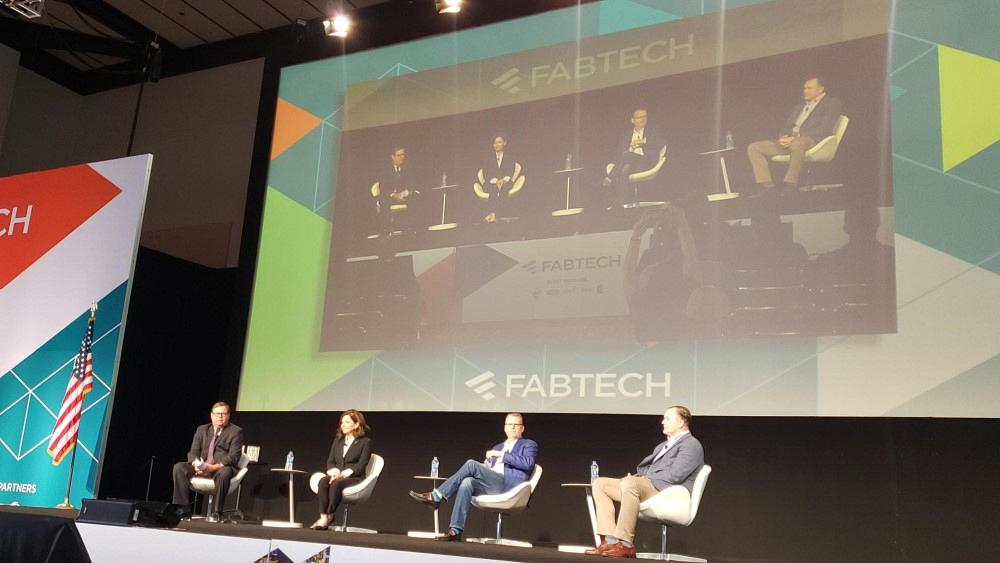Senior Editor
- FMA
- The Fabricator
- FABTECH
- Canadian Metalworking
Categories
- Additive Manufacturing
- Aluminum Welding
- Arc Welding
- Assembly and Joining
- Automation and Robotics
- Bending and Forming
- Consumables
- Cutting and Weld Prep
- Electric Vehicles
- En Español
- Finishing
- Hydroforming
- Laser Cutting
- Laser Welding
- Machining
- Manufacturing Software
- Materials Handling
- Metals/Materials
- Oxyfuel Cutting
- Plasma Cutting
- Power Tools
- Punching and Other Holemaking
- Roll Forming
- Safety
- Sawing
- Shearing
- Shop Management
- Testing and Measuring
- Tube and Pipe Fabrication
- Tube and Pipe Production
- Waterjet Cutting
Industry Directory
Webcasts
Podcasts
FAB 40
Advertise
Subscribe
Account Login
Search
FABTECH Reporter’s Notebook: About increasing manufacturing velocity
Leadership panel at FABTECH focuses on material prices and the absolute necessity of automation
- By Tim Heston
- September 16, 2021

Panelists Dan Davis, editor in chief, The FABRICATOR magazine; Adria Haines, regional head of smart factory solutions, Bystronic; Todd Ludlow, president, Ludlow Manufacturing; and Bryan Tice, senior partner, Metal Edge Partners, talk about industry challenges and what's ahead for 2022.
On Tuesday's State of the Industry panel discussion at FABTECH, Bryan Tice, senior partner, Metal Edge Partners, a risk management firm for the metals industry, had some good news to share. Steel might become just a tad more available.
“We certainly see some positive developments,” he said. “We track things like steel capacity utilization, and those rates continue to hold in the 85% range. And we’ve seen service center inventories rise from their low levels. Most inventories stand at around 39 to 40 days, so we’re starting to see some cushion.”
That’s something metal fabricators across North America can appreciate as the supply chain challenges continue unabated. Fabricators are buying more raw stock than ever, at least when they can find it.
Fellow panelist Todd Ludlow, president of Ludlow Manufacturing, a custom sheet metal fabricator just north of Chicago, shook his head and chuckled. “As I told someone here at the show, it’s gambling.”
Yes, fabricators might be caught with expensive raw stock when the pricing bubble pops, but few see that bubble popping anytime soon. Regardless, holding a lot of raw stock is less risky than running out and not being able to deliver. The cost of lost opportunity can be tremendous.
Still, holding all that raw stock has made manufacturing velocity more important than ever. “The goal has always been to automate as much as we can,” Ludlow said, who explained that his shop has added several laser cutting systems with material handing towers, automated part sorting, and upgraded software, all within the past six months. “I’m doing anything I can do to not eliminate employees but to not have to hire more, because I can’t find them.”
This includes part sorting, a process more and more fabricators, including small operations, are automating. After all, the last thing a fabricator wants is to invest in an incredibly productive cutting system only to have a bottleneck at the denesting station.
Multiple machine vendors here at FABTECH are communicating the value of increasing part velocity through automation. Picture this ideal: Raw stock emerges from a storage tower and arrives at the blanking center. Blanks are cut and automatically sorted on a pallet, which in turn is retrieved by an automated guided vehicle or, for more capability, an automated mobile robot. That robot travels to the automated bending station (which has already started an automated tool change), reorients the blanks to present them to the bending robot, which grasps the pieces, scans a barcode to identify the job, and commences the bending cycle. Formed parts are placed on a conveyor that carries pieces downstream to welding, coating, and shipping and packing.
Of course, this is just an ideal, and such a concept would fall short if overall part velocity, from raw stock to the shipping dock, slowed. Today’s modern fabricator, squeezed by high material prices, unreliable supply chains, and unrelenting customer demand, just doesn’t have that kind of time.
subscribe now

The Fabricator is North America's leading magazine for the metal forming and fabricating industry. The magazine delivers the news, technical articles, and case histories that enable fabricators to do their jobs more efficiently. The Fabricator has served the industry since 1970.
start your free subscriptionAbout the Author

Tim Heston
2135 Point Blvd
Elgin, IL 60123
815-381-1314
Tim Heston, The Fabricator's senior editor, has covered the metal fabrication industry since 1998, starting his career at the American Welding Society's Welding Journal. Since then he has covered the full range of metal fabrication processes, from stamping, bending, and cutting to grinding and polishing. He joined The Fabricator's staff in October 2007.
Related Companies
- Stay connected from anywhere

Easily access valuable industry resources now with full access to the digital edition of The Fabricator.

Easily access valuable industry resources now with full access to the digital edition of The Welder.

Easily access valuable industry resources now with full access to the digital edition of The Tube and Pipe Journal.
- Podcasting
- Podcast:
- The Fabricator Podcast
- Published:
- 04/16/2024
- Running Time:
- 63:29
In this episode of The Fabricator Podcast, Caleb Chamberlain, co-founder and CEO of OSH Cut, discusses his company’s...
- Industry Events
16th Annual Safety Conference
- April 30 - May 1, 2024
- Elgin,
Pipe and Tube Conference
- May 21 - 22, 2024
- Omaha, NE
World-Class Roll Forming Workshop
- June 5 - 6, 2024
- Louisville, KY
Advanced Laser Application Workshop
- June 25 - 27, 2024
- Novi, MI































